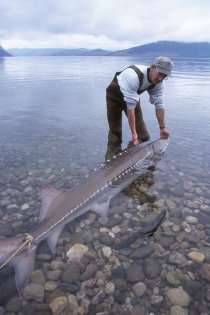Photographer Captures Dazzling Images of a Lightning Storm Dubbed the 'Night of a Thousand Forks'
These breathtaking images depict the incredible lightning storm that thundered over the Mexican state of Colima earlier this week.

For the first time in almost 40 years lake sturgeon have spawned in the Detroit River, thanks to an international reef construction effort completed last fall. The Detroit River International Wildlife Refuge announced Tuesday that the joint project between Canadians and Americans had succeeded in providing the perfect place for the threatened fish to lay eggs.
Just 12 miles southwest of Detroit, in Ontario waters along the shore of Fighting Island, officials found the right combination of flow, current speed, depth, and other factors that would attract the lake sturgeon.
"We were pretty confident it would work," said Dr. Patrick J. Rusz, Director of Wildlife Programs for the Michigan Wildlife Conservancy. "The amazing thing was that it happened so quickly."
Excessive fishing and water pollution had taken its toll on Michigan rivers, which were some of the best sturgeon fisheries in the world, even rivaling Russia's. Recently, new stringent fishing regulations along with pollution controls were setting the stage for a sturgeon comeback. There was just one problem.
A century ago, growing cities needed gravel for roads and concrete, and there was no better place to get gravel than a river bed. Over 8 million cubic yards of gravel had been dredged from that part of the Detroit River, removing a critical habitat for spawning sturgeon.
Recent population studies confirmed that despite lack of suitable spawning grounds, adult sturgeon congregated along Fighting Island near Wyandotte. Local, regional and international wildlife officials hatched a plan to surgically replace a small fraction of this key physical habitat to encourage spawning and help populations rebound.
"We are now seeing that even replacing a fraction can pay BIG dividends," said Rusz in a telephone interview with the Good News Network.
Barge operators dropped limestone and fieldstone in waters up to 20 feet deep while divers below monitored the construction of a 600 x 150 foot reef. The river's new spawning grounds were completed in late October 2008, an historic effort that marked the first time both Canadian and U.S. money was pooled for a common habitat rehabilitation project in the Great Lakes.
The governments of both nations were involved, with funding coming from the U.S. Fish and Wildlife Service, Environment Canada, National Fish and Wildlife Foundation, and the Ontario Ministry of Natural Resources. The Michigan Wildlife Conservancy, a private non-profit group, donated $30,000. Two U.S. companies—DTE Energy and BASF—also provided construction funds. The general contractor for the project was the Essex Region Conservation Authority (of Canada), with technical help from the U.S. Geological Survey, and other agencies and organizations.
The Detroit River International Wildlife Refuge is the only international refuge in North America. Managed by the U.S. Fish and Wildlife Service, it has 48 miles of what was once some of the continent's most productive shoreline for fish and wildlife. The Refuge is gradually expanding to provide critical habitat for many species of birds and fish that conservationists hope to see recover from decades of habitat loss.
The sturgeon is a great example. The current population is only about 1 percent of what it was 150 years ago. From 1970 to 1999, no sturgeon spawning was documented in the Detroit River. But since then, sturgeon have attempted to spawn in a few areas of the river, and more of the fish have been showing up down river near Fighting Island. Now, thanks to the efforts of two countries, the lake sturgeon, a threatened species in Michigan, have spawned four times this season using the man-made reef. Other Great Lakes fish such as walleye and lake whitefish, and even madtom, have also used the spawning grounds.
"It is so heartening to see the amazing success of this sturgeon habitat restoration for the Detroit River International Wildlife Refuge," notes Congressman John Dingell (D-MI). "No one thought this degree of success was possible only 30 years ago. It truly validates the decades of international cooperation on pollution control and conservation efforts in the River and throughout the Refuge. I want to give my special thanks to all the Canadian partners who made this possible and I look forward to continuing this important work with them in the future."
"Michigan Congressman John Dingell originally had a vision of restoring the wildlife especially in the Great Lakes and tributaries at a time when a lot of people scoffed at the idea, assuming no one could pull it off," recalls Dr. Rusz. "Lake Erie was once considered dead and now is a world class fishery once again… It's nice to see it has happened in his lifetime."
Lake sturgeon spend a lot of their time in waters 20 to 40 feet deep. They spawn in May or June in a variety of depths, typically 6 to 28 feet. While on river spawning grounds, sturgeon often break the surface with porpoise-like jumps. Females lay several hundred thousand eggs at a time.
Females become sexually mature at 25 years of age, males at 15. Females only spawn every 4 to 6 years, and males every other year. Some individual sturgeon have lived 150 years.
Sturgeon feed on sand or muck bottoms where they suck in bottom organisms including crayfish, snails, and larvae of mayflies and other insects.
(Thanks to the Michigan Wildlife Conservancy for much of this writing and reporting)
Be the first to comment